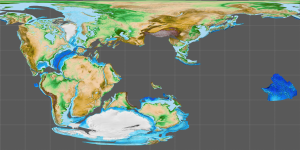This just in. gplates can actually move pieces of rasters on a globe.
So far I haven’t used this in anger. Just a proof of concept with existing data and imagery. For Earth, of course. People seem a little obsessed with that planet.
The usefulness of this for worldbuilding should be pretty clear. Start with some noise-generated worldmap. Treat that as the world of the distant past. Digitize some polygons over the apparent continental bounds. Use the pole transform tools to move the polygons about. Bash them together at least once. Split the resulting supercontinent into pieces of the new continents and move them into place. Just a little more information to drive the worldbuilder’s imagination.
I’ll post a full description of the technique along with my workflow later. For now, I’ll just give a capsule description.
First, import your raster as described here.
Similarly, import or more likely create your continental outline polygons. If you’ve been following along, this shouldn’t be too hard.
Import your .rot file. This has also been dealt with previously.
From the main menu, select Window>Show Layers. Make sure all of the parameters for the vector layer are shown. Under Inputs, there is a Reconstruction Tree item. Click Add New Connection and select your .rot file.
Now examine the parameters for your raster layer. In Inputs, under Reconstructed Polygons click Add New Connection and pick out your .rot file.
Now try playing the time sequence.
Any questions? Drop a comment and I’d be glad to help out.
Thank you,
The Astrographer

